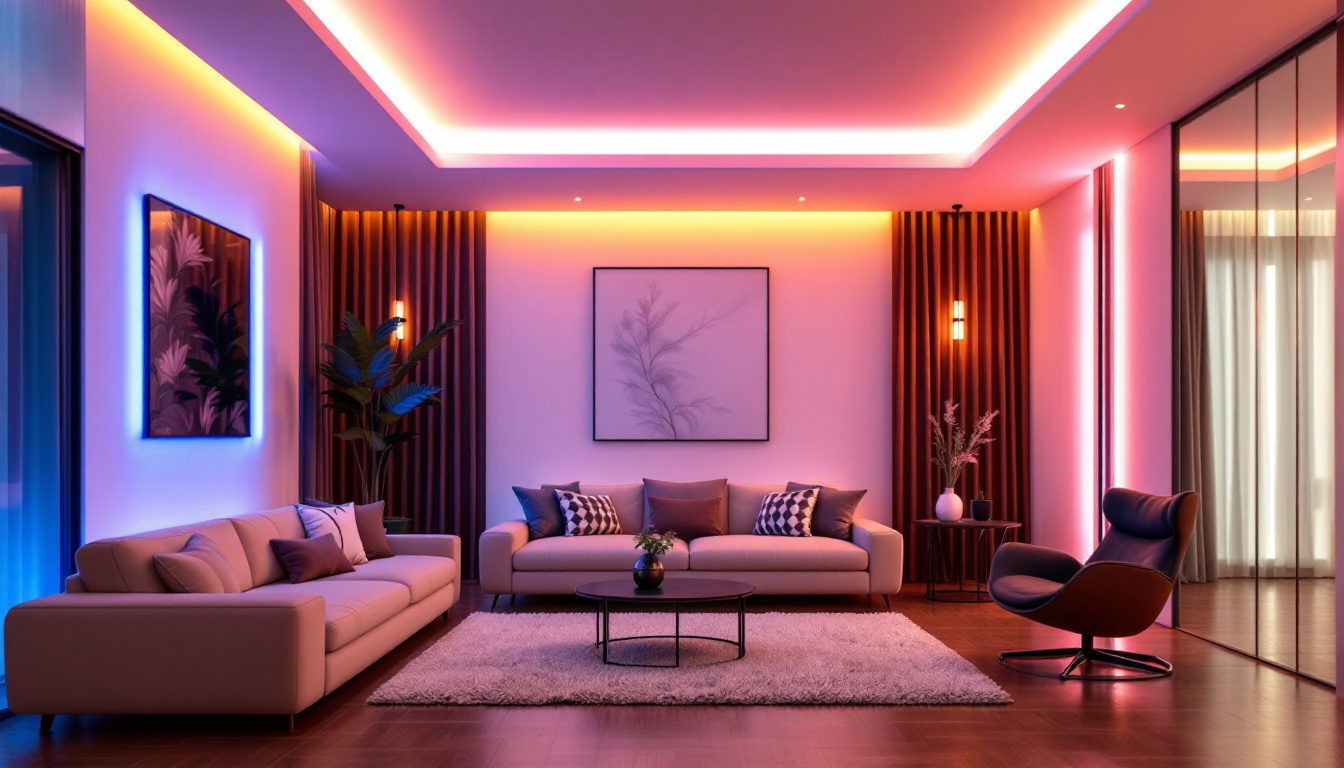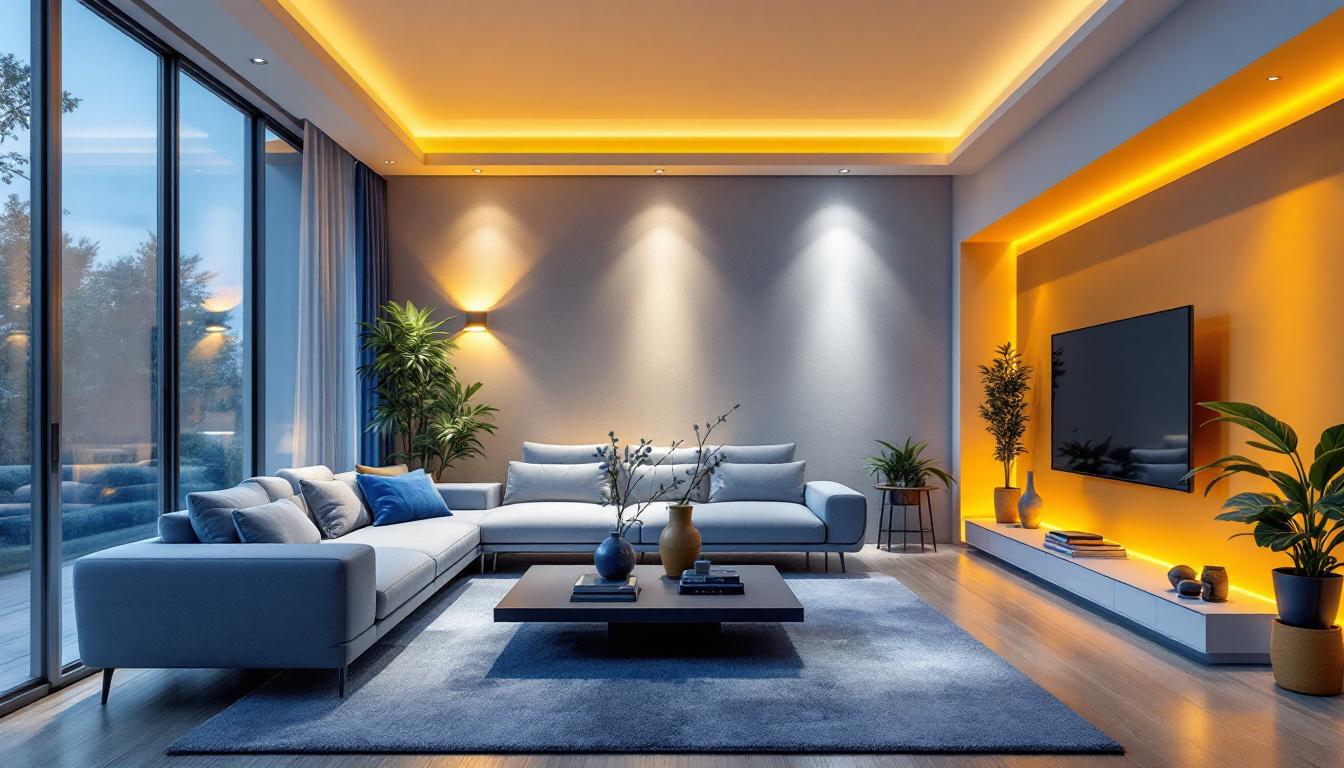
In the realm of modern lighting solutions, LED strip lights have emerged as a transformative option for both residential and commercial spaces. Their versatility and efficiency make them an essential tool for lighting contractors who seek to elevate their projects. This article delves into the benefits, applications, and installation techniques of LED strip lights, specifically focusing on their use in ceiling designs.
One of the most compelling reasons to incorporate LED strip lights into lighting designs is their energy efficiency. Compared to traditional incandescent or fluorescent lighting, LED strips consume significantly less power while providing the same, if not superior, brightness. This not only reduces energy bills for clients but also contributes to a more sustainable approach to lighting.
Furthermore, the long lifespan of LED lights—often exceeding 25,000 hours—means fewer replacements and less waste. For contractors, this translates into lower maintenance costs and happier clients who appreciate the longevity of their lighting solutions. The reduced heat output of LEDs also enhances safety, as they are less likely to cause burns or fire hazards, making them ideal for residential and commercial spaces alike. This combination of energy savings and safety makes LED strip lights a smart choice for environmentally-conscious consumers looking to make a positive impact on their energy consumption.
LED strip lights offer unparalleled design flexibility. They can be installed in a variety of applications, from accent lighting to task lighting, and can be easily integrated into different architectural features. Whether it’s illuminating a coffered ceiling, highlighting architectural details, or providing ambient lighting in a living space, LED strips can adapt to any design vision.
Additionally, these lights come in various colors and brightness levels, allowing contractors to customize the lighting to match the specific needs and preferences of their clients. This versatility makes LED strip lights a go-to solution for innovative lighting projects. Beyond just color options, many LED strips now feature smart technology, enabling users to control brightness and color temperature via smartphone apps or voice commands. This level of customization not only enhances the aesthetic appeal of a space but also allows for dynamic lighting scenarios that can change with the time of day or occasion, providing an immersive experience for users.
Another advantage of LED strip lights is their ease of installation. Most strips come with adhesive backing, allowing for quick and straightforward application on ceilings and other surfaces. This feature not only saves time during installation but also minimizes disruption to the space.
Moreover, many LED strips can be cut to length, enabling contractors to create a tailored lighting solution without the need for complex wiring or fixtures. This adaptability can significantly streamline the installation process, making it easier to meet tight project deadlines. Additionally, the lightweight nature of LED strips means they can be mounted in places where traditional fixtures would be impractical, such as under cabinets or along staircases. This opens up a world of creative possibilities for designers and homeowners alike, allowing them to explore unique lighting arrangements that enhance both functionality and aesthetics in any environment.
Accent lighting is a powerful tool in interior design, and LED strip lights excel in this area. By strategically placing strips along the edges of ceilings, contractors can create a soft glow that highlights architectural features or artwork. This technique not only enhances the aesthetic appeal of a room but also adds depth and dimension.
For instance, in a living room, LED strips can be installed in coves or recesses, providing a warm ambiance that invites relaxation. In commercial settings, such as restaurants or retail spaces, accent lighting can draw attention to specific areas, guiding customers through the space and enhancing their experience. Additionally, the versatility of LED strip lights allows for color-changing options, enabling designers to adapt the mood of the space for different occasions. For example, a restaurant could switch from a cozy, intimate setting in the evening to a vibrant, lively atmosphere during brunch hours, all with the flick of a switch.
In areas where focused lighting is essential, such as kitchens or home offices, LED strip lights can serve as effective task lighting. By installing strips under cabinets or shelves, contractors can provide direct illumination for work surfaces without the harshness of overhead lights.
This application not only improves functionality but also contributes to a cleaner, more organized look. Clients appreciate the practicality of having well-lit workspaces, and contractors can enhance their projects by incorporating these thoughtful lighting solutions. Moreover, LED strip lights can be integrated with smart home technology, allowing users to control the brightness and color temperature through mobile apps or voice commands, thus tailoring the lighting to their specific needs and preferences. This level of customization not only boosts productivity but also creates a more enjoyable working environment.
Ambient lighting sets the overall mood of a space, and LED strip lights can play a crucial role in achieving the desired atmosphere. By using dimmable LED strips, contractors can create a range of lighting effects, from bright and energizing to soft and calming.
In bedrooms, for example, dimmable strips can be installed around the perimeter of the ceiling to create a soothing environment conducive to relaxation. In contrast, in entertainment areas, brighter settings can enhance the vibrancy of the space, making it ideal for gatherings and celebrations. Furthermore, the use of LED strip lights in ambient lighting can be combined with other design elements, such as mirrors or textured wall finishes, to amplify the light’s reflection and create a more expansive feel in smaller rooms. This thoughtful integration can transform an ordinary space into a luxurious retreat, where the lighting complements the overall design and enhances the user experience.
Before installation begins, careful planning is essential. Contractors should assess the space and determine the best locations for the LED strips. Factors to consider include the height of the ceiling, the purpose of the lighting, and the desired effect. A well-thought-out layout can maximize the impact of the lighting and ensure even distribution.
Additionally, it’s beneficial to create a lighting design plan that includes measurements and specifications. This plan can serve as a guide during installation, helping to avoid common pitfalls and ensuring a professional finish.
For optimal adhesion, the surface where the LED strips will be installed should be clean and dry. Contractors should wipe down the area to remove any dust or grease that could affect the adhesive backing. In some cases, it may be necessary to use a primer or adhesive promoter to enhance the bond.
Once the surface is prepared, measuring and cutting the LED strips to the desired length can be done. Most strips have designated cut points, allowing for precise adjustments without damaging the circuitry. This step is crucial for achieving a seamless look in the final installation.
After the strips are installed, connecting them to a power source is the next step. Many LED strips come with connectors that simplify this process, allowing for easy integration into existing electrical systems. For contractors, understanding the electrical requirements and ensuring compliance with local codes is vital to a successful installation.
Furthermore, incorporating smart controls can elevate the functionality of the lighting system. By using dimmers or smart home integration, clients can easily adjust the lighting to suit their needs. This added feature not only enhances user experience but also positions contractors as forward-thinking professionals in the lighting industry.
While LED strip lights are known for their efficiency, they can still generate heat, especially when used in long runs or high-output applications. Proper heat management is crucial to maintain the longevity and performance of the lights. Contractors should consider using heat sinks or ensuring adequate ventilation in enclosed spaces to mitigate this issue.
Additionally, selecting high-quality LED strips that are designed for heat dissipation can help prevent overheating. Educating clients on the importance of heat management can also foster trust and demonstrate a commitment to quality workmanship.
Color consistency is another challenge that contractors may face when using LED strip lights. Variations in color temperature can lead to an uneven appearance, detracting from the overall design. To address this, it’s important to source LED strips from reputable manufacturers that guarantee color consistency across their products.
Furthermore, testing the strips in the actual installation environment before finalizing the design can help identify any discrepancies in color. This proactive approach ensures that the final result meets the client’s expectations and enhances the overall aesthetic.
Educating clients about LED strip lights and their benefits is essential for successful projects. Many clients may be unfamiliar with the technology or have misconceptions about its capabilities. Providing clear explanations about energy efficiency, design possibilities, and maintenance can empower clients to make informed decisions.
Additionally, offering guidance on how to operate and maintain the lighting system can enhance client satisfaction. By positioning themselves as knowledgeable experts, contractors can build lasting relationships with clients and encourage repeat business.
Incorporating LED strip lights into ceiling designs is not just a trend; it is a strategic move that can elevate lighting projects to new heights. Their energy efficiency, design flexibility, and ease of installation make them an indispensable tool for lighting contractors. By understanding the various applications, installation techniques, and challenges associated with LED strip lights, contractors can deliver exceptional results that meet and exceed client expectations.
As the demand for innovative lighting solutions continues to grow, embracing LED technology will position contractors at the forefront of the industry. By harnessing the potential of LED strip lights, lighting professionals can create stunning, functional spaces that leave a lasting impression.
Ready to take your lighting projects to the next level with LED strip lights? Look no further than LumenWholesale for all your lighting needs. Our extensive range of top-quality, spec-grade lighting products comes at unbeatable wholesale prices, ensuring you get the best value for your investment. Say goodbye to inflated markups and hello to superior lighting solutions that meet the highest industry standards. Plus, with free shipping on bulk orders, you can stock up on premium lighting without any hidden fees. Elevate your lighting projects with the perfect blend of quality, affordability, and convenience at LumenWholesale. Wholesale Lighting at the Best Value.

Explore the transformative impact of four-foot LED lights in contemporary lighting solutions.

Explore the enduring charm and practical benefits of gas lighting in historic homes.

Discover the hidden techniques lighting contractors use to transform spaces with architectural lamps.

Discover how recess can lights can transform your lighting installations into profitable ventures.